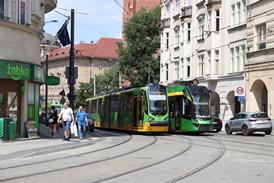INTRO: Infrafer’s business
Sir - We would like to point out some important corrections to the article on Algeria by Dr Kadi Abdelsselam in Rail Business Report 1998.
The article states that Infrafer is a subsidiary of the Algerian Railways (SNTF). While Infrafer was originally spun off from the SNTF in August 1986 after restructuring, today Infrafer is a stand alone separate company.
Infrafer is the main contractor for SNTF’s new track building, renewal and infrastructure maintenance programme. Since its creation, Infrafer has not only renewed 100 km of rail, sleeper and ballast as stated by Mr Kadi, but has achieved much more than that. Its work includes renewal of track and ballast on 1050 km, laying 270 km of new track, ballast cleaning and renewal on a further 400 km, installation of 400 turnouts and fabrication of more than 2 million twin-block concrete sleepers.
Infrafer owns about 40 track maintenance and construction machines. This gives it the ability to renew more than 200 track-km a year. The company also has 150 civil engineering machines including earthmovers and other equipment able to prepare track formations. It also produces its own twin-block sleepers at four sites, which together can deliver up to 3 million sleepers a year. Infrafer also operates four sites which together produce up to 3million m3 of ballast a year, and supply the sleeper factories with aggregates.
The company is structured so that activities are integrated and it operates on an independent basis. The only imported components are rail and fastenings; everything else is produced locally. Infrafer also has three well-equipped maintenance depots distributed across the country.
In 1995, to enhance its efficiency, Infrafer acquired two rail welding machines featuring the latest technology.
To give readers some idea of our company, Infrafer employs more than 1800 workers, of whom about 100 are university graduates and very skilled technicians.
H Saidi
General Manager, Infrafer
Alger, Algeria
INTRO: Changing places
Sir - You have previously recorded (RG 11.97 p735) the dismissal of S Ramanathan, General Manager, South Eastern Railway and N C Sinha, General Manager Central Railway. This is not the case. Mr Ramanathan is now General Manager of Eastern Railway and Mr Sinha now holds the post of General Manager at South Central Railway.
S Ramanathan, General Manager, Eastern Railway, Calcutta, India
INTRO: Freight Freeway success factors
Sir - Referring to your interesting article on Freight Freeways (RG 5.98 p313), I should like to make a few remarks.
In Fig 1 you have erroneously switched the caption. ’Average freight revenue Ecu per 100 tonne-km’ should be black and ’North-South Terff charges Ecu per train-km’ should be red. The figures correspond with the officially published freeway infrastructure charges (Netherlands 1Ecu; Germany DM8·75; Switzerland ?…SFr7·00; Italy ?…9000 lire). With the exception of the Netherlands, infrastructure charges vary according to the route in question, hence the averages.
I would like to make a few other points to put this development in a better context. May I once and for all take away the myth that freight trains trundle across Europe at an average speed of 16 km/h. This may be the case for an isolated individual wagonload consignment, but certainly not for NS Cargo’s efficient intermodal shuttles from Rotterdam developed with its partner railways since 1993, which average 45 to 55 km/h over long distances. We also run about 250 trains a week at similar speeds to 27 destinations throughout Europe on behalf of other intermodal operators.
The limit to raising speeds further is the process of pathing over the whole route. This is one of the key challenges for the new One-Stop-Shops. Major obstacles are:




















